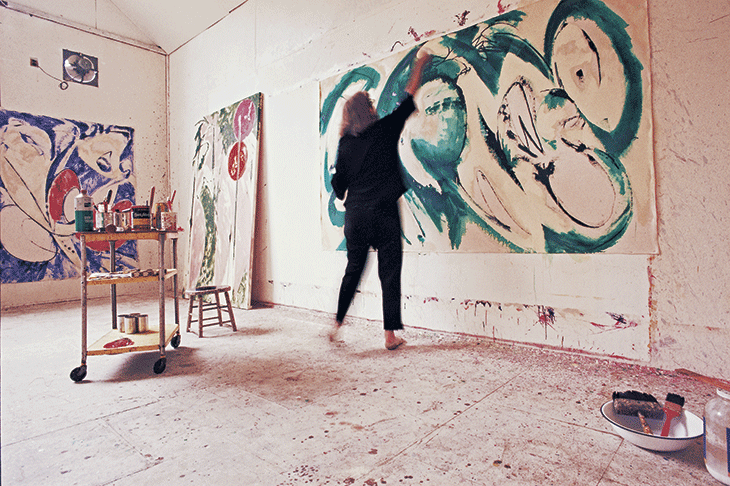A stiff, invigorating breeze of revisionism is blowing through stuffy art history. Is it really true that all the valuable traffic was on a mainline between Paris and New York, with modest sidings in London, Barcelona and Zurich? Was the adventure of modern art an exclusively masculine journey across the North Atlantic?
Suddenly, it has been discovered that there were modernists at work in Latin America and Africa too. An exhibition of Carmen Herrera, a Cuban abstractionist, in New York’s Whitney Museum two years ago was a sensation. The more so, of course, because Herrera (now 103) is a woman. The Tate has recently shown that Dorothea Tanning was at least as interesting as her better-known husband, Max Ernst. Hilma af Klimt at the Guggenheim has astonished New York.
In this way we approach the dismal swamps of ‘feminist art history’. Casual, or possibly even formal, misogyny is a recurrent theme in this properly sourced and densely footnoted new biography of the Widow Pollock. Is it true that Lee Krasner sacrificed her own career, one based on an impressive art education, for the benefit of her drunk and depressive husband, Jack the Dripper? Many people then and now thought her the better painter.
Krasner, who died aged 75 in 1984, came from a generation not empowered by the women’s movement. Although she did participate in a 1972 New York demonstration complaining that of 1,000 or so one-man shows staged by the Museum of Modern Art in 40 years, only five had been one-woman shows. Was this blind prejudice by MoMA? Might there have been other reasons? Gail Levin does not quite say.
An element of grievance is indelible in this book because Krasner, whose family emigrated from the Pale of Settlement was, besides being hobbled by gender, Jewish too. And her Brooklyn of cold-water walk-ups was more anti-Semitic in 1908 than it is today. Yet she was by every account a proud, strong-willed, principled, uncompromising, even, some said, ferocious individual. The playwright Edward Albee commented: ‘She looked you straight in the eye and you dared not flinch.’
Yet (even if the art historian Anita Brookner had in a Burlington Magazine review assumed ‘Lee’ was a man) Krasner did not herself overplay the obstacles of discrimination. She said: ‘I’m an artist, not a woman artist.’ And the big question must be how good an artist. It’s a question, Levin’s arguments aside, this book only partially answers, since the illustrations are meanly monochrome (crazy when her painting is about luminosity and brilliance) and the design undistinguished.
This is a loss, since very few people have seen real Krasners. Only the elderly can recall the retrospective at the Whitechapel in 1965 (her first anywhere) and the Tate has but a single example of her work, a 1961 canvas called ‘Gothic Landscape’. An imminent Barbican show (30 May–1 September) will correct this.
Her early work was eclectic with influences from Cezanne, Matisse, Miro and, eventually, Jackson Pollock. Her mature style was vigorously non-figurative, but made references to mythology and biomorphic forms. A witness said she liked to slash the canvas as if with a knife, a vengeful yenta getting to grips with Fate. The pictures, she said, were ‘autobiographical’, although she left little written documentary material. Levin compensates by drawing on her close personal relationship with the painter and a multitude of interviews.
But, revisionist or not, there is no gainsaying that the big fact of Krasner’s career was her husband. When they met in 1942, she was already establishing a reputation as a modernist painter, while Pollock had not yet discovered himself and was still working in the style of his teacher, Thomas Hart Benton, a sentimental realist.
And then Jack began to drip, at first tentatively, soon very successfully. America had, to the approval of the media, its first homegrown modern artist. What follows is a narrative of wifely devotion: Krasner’s commitment to building Pollock’s career, compromising her own the while, in an idyll of domesticity with griddle cakes and maple syrup at their cottage in East Hampton.
Except he was a foul-mannered, alcoholic, womanising, self-pitying, brawling brute. Krasner was on a trial separation in Paris in 1956 when she took the call telling her Jackson had killed himself and a passenger, a local beautician, in a driving-under-the influence car crash. Another passenger was Pollock’s mistress du jour, the ‘sensationally beautiful’ and sensationally ambitious Ruth Kligman, who survived to write a sensational account of her life with Pollock that was published in 1974. Krasner memorably said Kligman’s book should be called: ‘My Five Fucks with Jackson Pollock… because that’s all there were.’
After his death, Krasner managed the Pollock estate, making judicious loans to important museums and exhibitions, the official curator of his life as well as his art, but also now free to develop her own career. This was sanctified first in a 1981 New York show called ‘Krasner/Pollock: a working relationship’. Second, in this impressively researched biography.
The fascinating subject of artists’ widows is touched upon in David Plante’s splendidly incorrect Difficult Women (1983). And Krasner’s own bohemian milieu in New York (a source of such rich 20th-century mythology) has recently been described in Mary Gabriel’s Ninth Street Women (2017), referring to the Greenwich Village site of the Artists’ Club where Krasner, Helen Frankenthaler and Elaine de Kooning were very busy repudiating the male hegemony in art, while making art, fighting and drinking just like their menfolk.
Was Lee Krasner an artist’s widow of global stature, or an artist of global stature in her own right? After reading this welcome, if slightly lifeless, book, I decided the former.






Comments